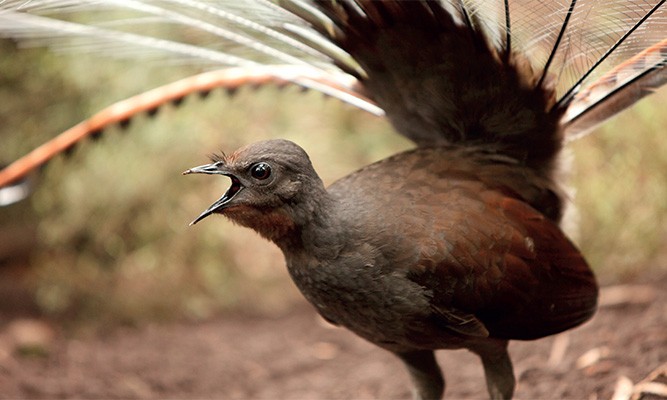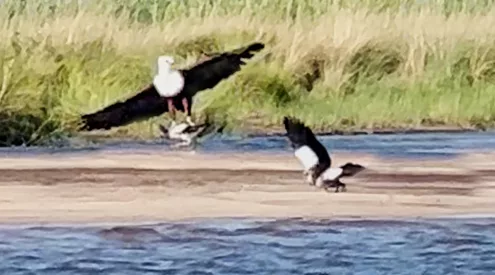The first music our species ever heard was undoubtedly the songs of birds. Feathered mini-dinosaurs have been trilling from trees for much longer than there have been human ears to hear them – and the songs they sing still inspire us.
The melodies of many great composers were filched from birds and, today, with recording equipment or a good musical ear, their violation of avian copyright can be detected.
The famous opening bars of Beethoven’s Fifth Symphony is a direct crib from the white-breasted wood wren and the beginning of his Violin Concert in D, Opus 61, is from a blackbird. At the end of the second movement of his Pastoral Symphony, a clarinet does the perfect imitation of a cuckoo. In fact, his music is littered with birdsong.
The thrilling cascade at the opening of Chopin’s extraordinary Etude in C Minor is, note for note, that of the canyon wren. Olivier Messiaen’s flute piece Le Merle Noir was based entirely on the song of the blackbird and his orchestral work, Réveil des Oiseaux, is blended from the dawn bird chorus in the Jura Mountains of the composer’s native France.
Messiaen began this focus in a Nazi prison camp in 1940 while composing The Quartet for the End of Time, his first piece to use birdsong and one of his greatest. Years later he wrote: ‘In my hours of gloom, when every musical idiom appears to me as no more than admirable painstaking experimentation, what is left for me but to seek out the true face of music somewhere off in the forest, among the birds.’
Composer Jonathan Harvey has combined recordings of birds’ songs, their pitch and rhythm lowered and slowed down, in his Piano Concerto with Birdsong.
In Stravinsky are patterns that match a bird from the region where he worked. Mozart used the song of his pet starling in a concerto (birds reportedly like listening to his music). Vivaldi wrote a concerto to a goldfinch and birdsong can be identified in the works of Mahler, Delius, Ravel, Wagner and many others.
Our debt to birdsong may go deeper than this, however. In Kerula, southern India, Brahmans teach their sons sacred mantras that aren’t any known language and are said to go back to ‘before time’. Frits Staal, a researcher from Berkley University in the USA, found their sound patterns related to birdsong and nothing else. He proposed that the mantras come from a pre-language era and that human speech may have developed in imitation of birdsong.
At least 20 per cent of birds are what’s termed open-ended learners – they innovate. The blackbird, for example, starts his song at the beginning of spring with a number of simple phrases upon which he elaborates over the next three months, by which time he’s composed a substantial musical piece. The following year it will be a different song. There’s no scientific explanation as to why he does this, other than because he can and because he enjoys singing.
Birds, however, also imitate our sounds and are changing their tune because of us. Some do it by direct mimicry and top of this class isn’t the parrot, but the Australian lyrebird. They sound in their pursuit of a new tune to attract a mate: the clicking of cameras, chainsaws, drills and car sirens.

In 1969, ranger Sydney Curtis heard a lyrebird producing flute sounds in New England National Park on the coast of New South Wales. After some sleuthing, he discovered that in the 1930s a neighbouring farmer had played the flute for a pet lyrebird which had then escaped. When ornithologist Norman Robinson studied the call, he discovered that males in the area were singing two popular songs from the period: The Keel Row and Mosquito’s Dance – 70 years later.
We’re also limiting birdsong with our noise. Biologists at the Netherlands’ University of Leiden, Hans Slabbekoorn and Ardie den Boer-Visser, found that birds in cities are changing their songs. They’re speeding up their tunes by shortening the first note and pauses while dropping the low notes.
The reason, they found, is that the sonorous dawn and dusk mating song of the red-blooded male broadcasting his readiness to breed is being lost in the deep growl of rush-hour traffic. Instead, what’s getting the attention of females is the geeky peeps of a new generation of hipsters with an ear for the right pitch. This has happened over the past 30 years and the new dialects are trickling back into the countryside.
Male birds sing to defend their territory and demonstrate their breeding fitness to an attentive female. The more varied their repertoire, the greater their chance of luring a mate. Low notes are lost in the traffic, while frequencies that are too high bounce off the hard surfaces of buildings and confuse. So urban sexual selection favours the mezzo-sopranos.
Which brings me to the hadeda. In almost any Southern African city these days dawn breaks to their high-pitched shriek. They were once heard in only the forested areas of the Great Rift Valley but are now everywhere, even Cape Town.
I was high in the Simien Mountains overlooking the Rift in Ethiopia one day when the hadeda’s closest relative, the wattled ibis, landed in a tree near me. But instead of going ‘ha-eek-ah’ it went ‘aah-grr’ very deeply and looked around, as these birds do, for applause.
Now the wag’s version around where I live is that hadedas go ‘ha-eek’ as they fly because they’re afraid of heights. But a more likely reason is that all they’re trying to do is be heard above the roar of traffic. It’s not music to our ears, but who can blame them?
















